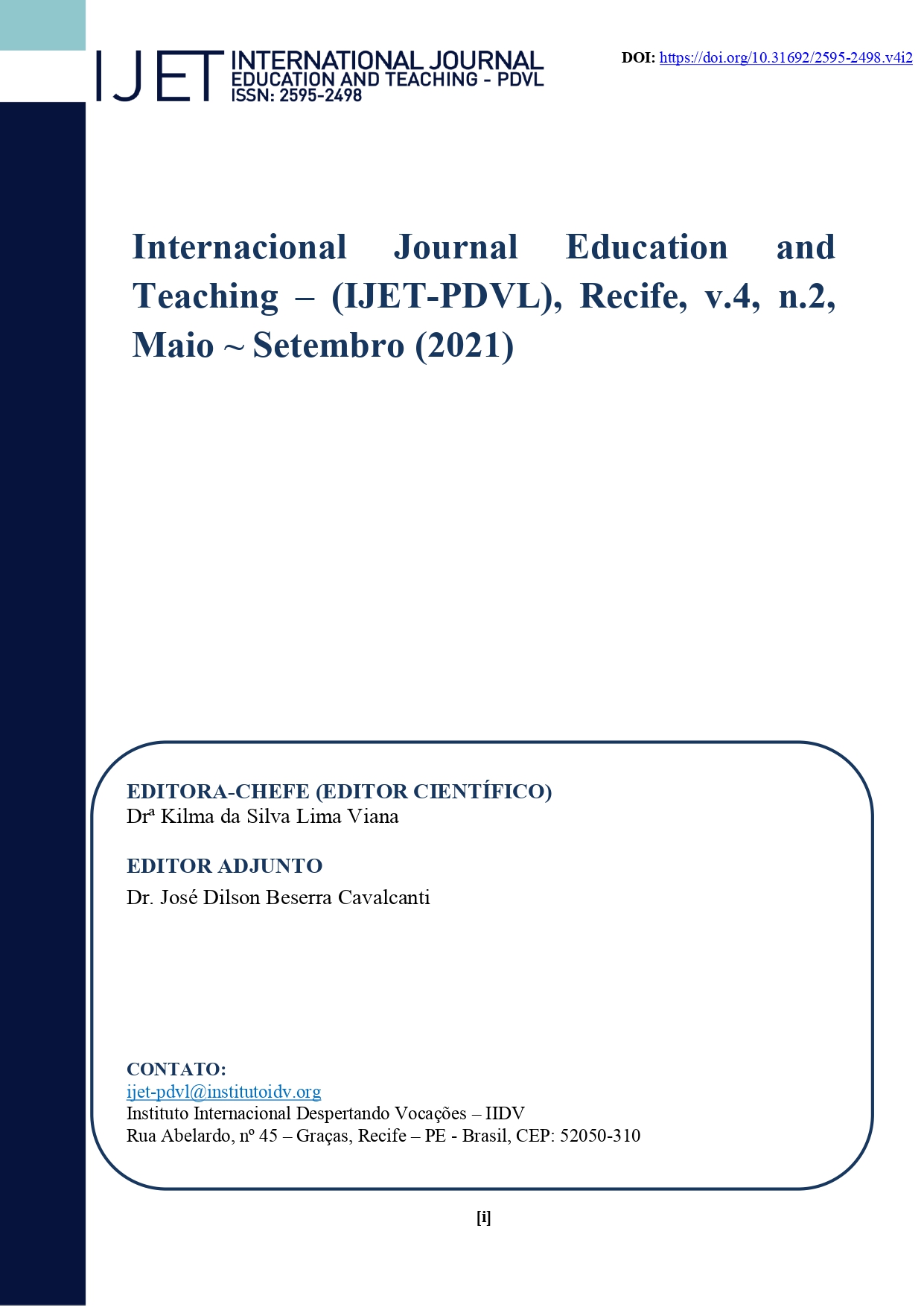LA TECNOLOGÍA COMO ESTRATEGIA PUENTE EN LA ENFERMERÍA EN LOS TIEMPOS COVID-19
Palabras clave:
Educación a Distancia, COVID-19, Enfermería, SaludResumen
Identificar, a través de la literatura, la metodología utilizada fue a través de una revisión integradora de la literatura que tiene como objetivo contribuir a la reflexión de los profesionales y estudiantes del campo de la enfermería, así como de los interesados en el tema. El artículo se basó en evidencia científica. Con una búsqueda realizada por la Biblioteca Virtual en Salud (BVS) en las bases de datos MEDLINE y LILACS, las palabras clave seleccionadas fueron: Educación a Distancia, COVID-19, Enfermería y Salud, encontradas con la ayuda de los Descriptores de Ciencias de la Salud (Decs), utilizando el émbolo "Y", utilizando como criterio de inclusión: artículos publicados entre 2020 y 2021. se encontraron 599 artículos en la búsqueda electrónica, de estos, 530 continuaron después de cada criterio de inclusión y 7 fueron seleccionados para la muestra final de este estudio . El análisis de los datos permitió inferir que cuando existe un cuerpo docente capacitado por la institución educativa, es
posible romper las barreras, brindando el apoyo necesario a los estudiantes, lo que puede reflejarse en la formación de futuros enfermeros asistenciales y patrocinadores científicos. El estudio realizado tuvo limitaciones en cuanto a los impactos en el área de enfermería, ya que la mayor cantidad de investigaciones se centraron en el sector médico, así como una pequeña cantidad de artículos que abordan cómo los estudiantes de enfermería podrían enfrentar los desafíos de la era tecnológica en el escenario de pandemia en el que vivimos. Las calificaciones tanto de los profesores como de los estudiantes desde el momento de la inserción en la institución de estudiantes pueden contribuir a facilitar la adaptación, en caso de que surjan calamidades públicas.
Descargas
Referencias
ANSARI K, et al. Percepção sobre ensino e aprendizagem online entre estudantes de ciências da saúde em instituições de ensino superior durante o bloqueio COVID-19 - maneiras de melhorar o ensino e a aprendizagem em faculdades e universidades sauditas. F1000Research 2021, 10 : 177. Disponível em: <https://f1000research.com/articles/10-177/v1>. Acesso em: 18 mai. 2021
BRASIL. MINISTÉRIO DA SAÚDE. Como é transmitido? Brasília. Disponível em:< https://www.gov.br/saude/pt-br/coronavirus/como-e-transmitido>. Acesso em: 18 mai. 2021.
BANCO MUNDIAL. 2020. A pandemia do COVID-19: choques nas respostas à educação e às políticas . Banco Mundial, Washington, DC. Disponível em:< https://openknowledge.worldbank.org/handle/10986/33696>. Acesso em: 10 mai.2021.
CARPIO et al. Distance learning in third year stomatology students during the Covid-19. MEDISAN vol.24 no.5 Santiago de Cuba sept.-oct. 2020 Epub 21-Sep-2020. Disponível em: < http://scielo.sld.cu/scielo.php?script=sci_arttext&pid=S1029-30192020000501014>. Acesso em: 11 mai.2021.
COFEN, Conselho Federal de Enfermagem. Relatório das Audiências Públicas Formação de Profissionais de Enfermagem na Modalidade a Distância. Disponível em: http://www.cofen.gov.br/wpcontent/uploads/2017/03/RELAT%C3%93RIO-AUDI%C3%8ANCIAS-P%C3%9ABLICAS-%E2%80%93 FORMA%C3%87%C3%83O-DE PROFISSIONAIS-DE-ENFERMAGEM-NA-MODALIDADE-EAD-final-1.pdf. Acesso em: 11 mai. 2021.
GAFFNEY Mk et al. COVID-19 Disruption of Nursing Education and the Effects on Students' Academic and Professional Confidence. Nurse Educ. 2021 Mar-Apr 01;46(2):76-81. Disponível em: < https://journals.lww.com/nurseeducatoronline/Abstract/2021/03000/COVID_19_Disruption_of_Nursing_Education_and_the.9.aspx>. Acesso em: 12 mai. 2021.
HASLAM.,Mb. O que o COVID-19 pode ter nos ensinado sobre a entrega da Educação do Enfermeiro, em um mundo pós-COVID-19? Enfermeira Educação Hoje. Volume 97 , fevereiro de 2021, 104707. Disponível em: <https://www.sciencedirect.com/science/article/pii/S0260691720315574?via%3Dihub>. Acesso em: 16 mai. 2021.
Ho IMK et al. (2021) Prevendo a satisfação do aluno com o aprendizado remoto de emergência no ensino superior durante o COVID-19 usando técnicas de aprendizado de máquina. PLoS ONE. Disponível em: <https://journals.plos.org/plosone/article?id=10.1371/journal.pone.0249423#sec011> Acesso em: 13 mai. 2021.
Johns Hopkins University. Coronavirus COVID-19 Global Cases by Johns Hopkins CSSE. Johns Hopkins University. 2020. Dísponível em: > https://www.arcgis.com/apps/dashboards/bda7594740fd40299423467b48e9ecf6 < Centro de Engenharia de Ciência e Sistemas (CSSE) da Johns Hopkins University (JHU). Acesso em: 10 mai. 2021.
SHEA, Kl. Preparação para a pandemia do COVID-19 e seu impacto no currículo de simulação de enfermagem. Journal of Nursing Education Vol. 60, nº 1. Vol 46 - Edição 2 - p 76-81. Disponível em: <https://journals.healio.com/doi/10.3928/01484834-20201217-12>. Acesso em: 18 mai. 2021.
SINGH et al. A survey of E-learning methods in nursing and medical education during COVID-19 pandemic in India. Nurse Education Today. Vol 99, April 2021, 104796. Disponível em : <https://www.sciencedirect.com/science/article/abs/pii/S0260691721000538?via%3Dihub>. Acesso em: 12 mai. 2021.
XAVIER,Ab et al. O ensino de Enfermagem e os desafios do uso de tecnologias remotas em tempos de pandemia do coronavírus (covid-19). Brazilian Journal of Development, Curitiba, v.7, n.1,p.8667-8682Jan. 202Disponível em:<https://www.brazilianjournals.com/index.php/BRJD/article/view/23600/18970> Acesso em: 14 mai. 2021.
Descargas
Publicado
Número
Sección
Licencia
Derechos de autor 2021 Débora Cristina de Lima Leão Cavalcanti (Autor)

Esta obra está bajo una licencia internacional Creative Commons Atribución 4.0.






